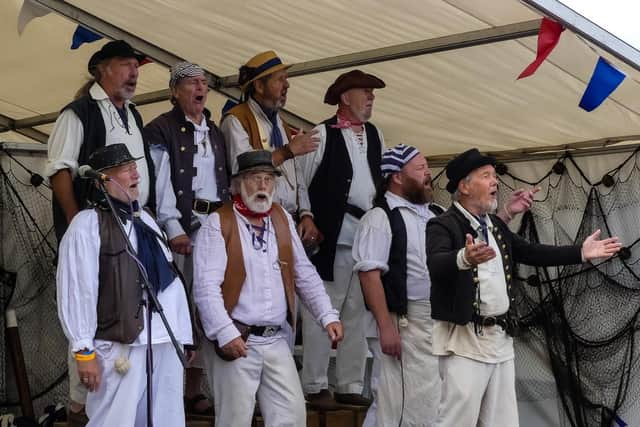Sea shanty TikTok: what is a Wellerman, who is Nathan Evans - and why #ShantyTok is trending during Covid-19
and live on Freeview channel 276
A former postman who became a viral TikTok star has landed the number one spot in The Official Big Top 40 music chart.
Evans, 26, from Airdrie, Scotland, quit his job as a postman after kick-starting a new viral craze of sea-shantying on TikTok (dubbed #ShantyTok) and signing a record deal with Polydor Records.
Advertisement
Hide AdAdvertisement
Hide AdHis song ‘Wellerman’ is the new number one in the chart, with a remix of the song by 220 KID and Billen Ted taking number three.


It beat Olivia Rodrigo’s ‘Drivers License’, Ed Sheeran’s ‘Afterglow’ and Riton & Nightcrawlers’ ‘Friday’ to take the top spot.
Here is everything you need to know.
What is a sea shanty?


Sea shanties are a type of “work song” that was once a common fixture of most maritime settings.
They were sung to pass the time and make the hard graft of life at sea a little more bearable, and could often be heard ringing through the sails of large merchant ships.
Advertisement
Hide AdAdvertisement
Hide AdNot only did they provide a means to take one's mind off menial tasks, sea shanties also provided a rhythm for workers to follow.
This would synchronise a labour force thus making them more efficient – especially of use when much ship work required team efforts to weigh anchor and set sail.
It’s not entirely clear where they came from, though it’s thought shanties originated in the mid-19th century on American merchant vessels and the ports of the southern United States, and quickly spread around the world during a period of fertile trade and travel.
Their style derives from a number of origins like folk songs, popular music of the time and marching songs.
Advertisement
Hide AdAdvertisement
Hide AdMany shanties centre around a call and response format, and most were often designed to accommodate improvisation and could be lengthened or shortened to match the task at hand.
Their ‘performance’ was led by a shantyman, who earned his title through a combination of lyrical wit and a strong voice, and were sung without instrumentation.
As shipwork became more automated with the introduction of steam-power and other mechanical innovations, shanties’ use gradually diminished, and the practice once so widespread died out.
Who is Nathan Evans?
It's being dubbed #ShantyTok by social media users, and sea shanties have become commonplace on TIkTok since the start of the year.
Advertisement
Hide AdAdvertisement
Hide AdYes, the traditional songs once sung to make hard labour at sea a little more bearable are gaining a resurgence in the 21st century.
The platform – which allows users to share creative video clips – has been inundated with people’s own renditions of traditional shanties, and those that have gone viral have been incorporated into other videos in surprising ways.
So where has this all come from?
Nathan Evans, a 26-year-old postman who resides near Glasgow, could be considered the “source”.
On 27 December, he uploaded a video to TikTok of himself singing a version of 19th century New Zealand folk song, ‘Wellerman’.
Advertisement
Hide AdAdvertisement
Hide AdThat post racked up millions of views – "It went wild, I don't really know what happened," Evans told cNet – and the singer’s follower count increased by nearly 800 per cent.
What is the ‘Wellerman'?
The song tells the story of whalers waiting on a resupply ship, its title in reference to The Weller Bros, an Australian whaling company that operated along the southern coast of New Zealand from 1830 to 1840.
Evans is no stranger to making music, and before his newfound fame regularly posted videos of himself singing Scottish folk songs and his own material.
Other users have used TikTok to virtually ‘duet’ with Evans – through the app’s split-screen function which allows you to record over the top on an existing clip – adding harmonies, instrumentation, and in once case even reworking the song into a techno club banger.
Advertisement
Hide AdAdvertisement
Hide AdEvans’ version of ‘Wellerman’ is a cover of Bristol group The Longest Johns’ 2018 song, which also entered the Official Top 40 a couple of weeks ago, debuting at Number 37.
Why are shanties trending?
It’s not entirely clear just why shanties have captured the imagination of TikTok’s relatively youthful audience.
But perhaps their original purpose of bringing together a crew has found a renewed relevance in the age of Covid-19, when so many of us want to be together at a time in which we’re forced apart.
“Back in the day when the shanties were sung, it was to bring everybody together, to keep them all in time, to keep the morale high,” said Evans.
“Especially in this time when everybody’s stuck at home, they’re doing their remote working – they can join in, and it kind of brings everybody together.”

